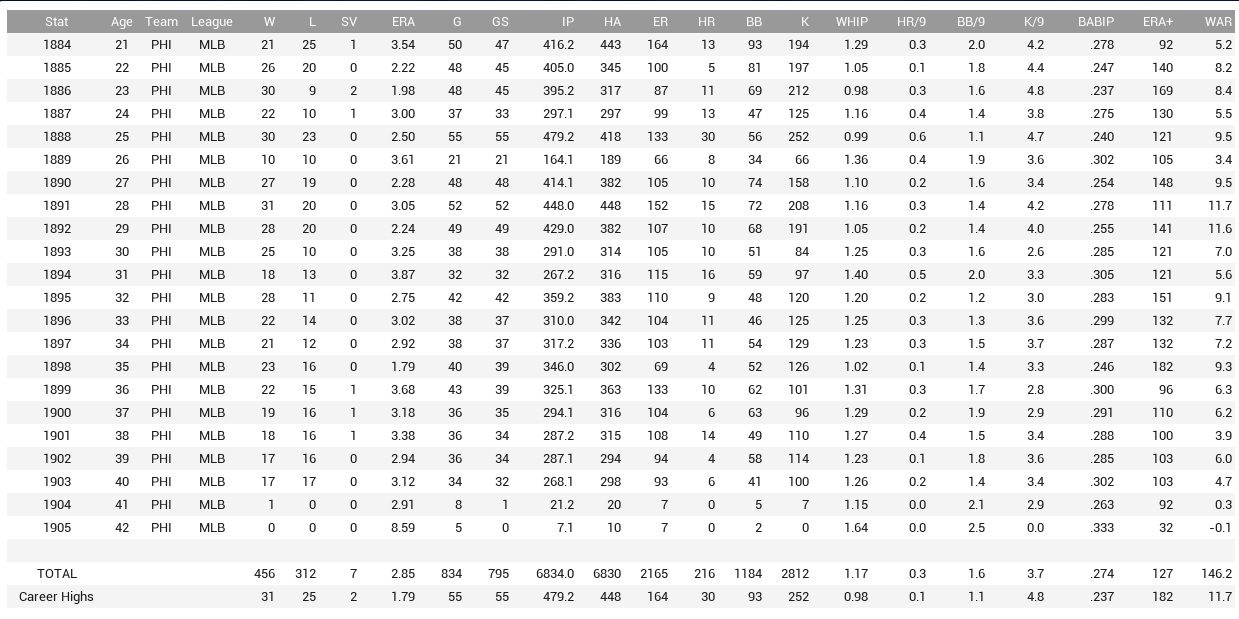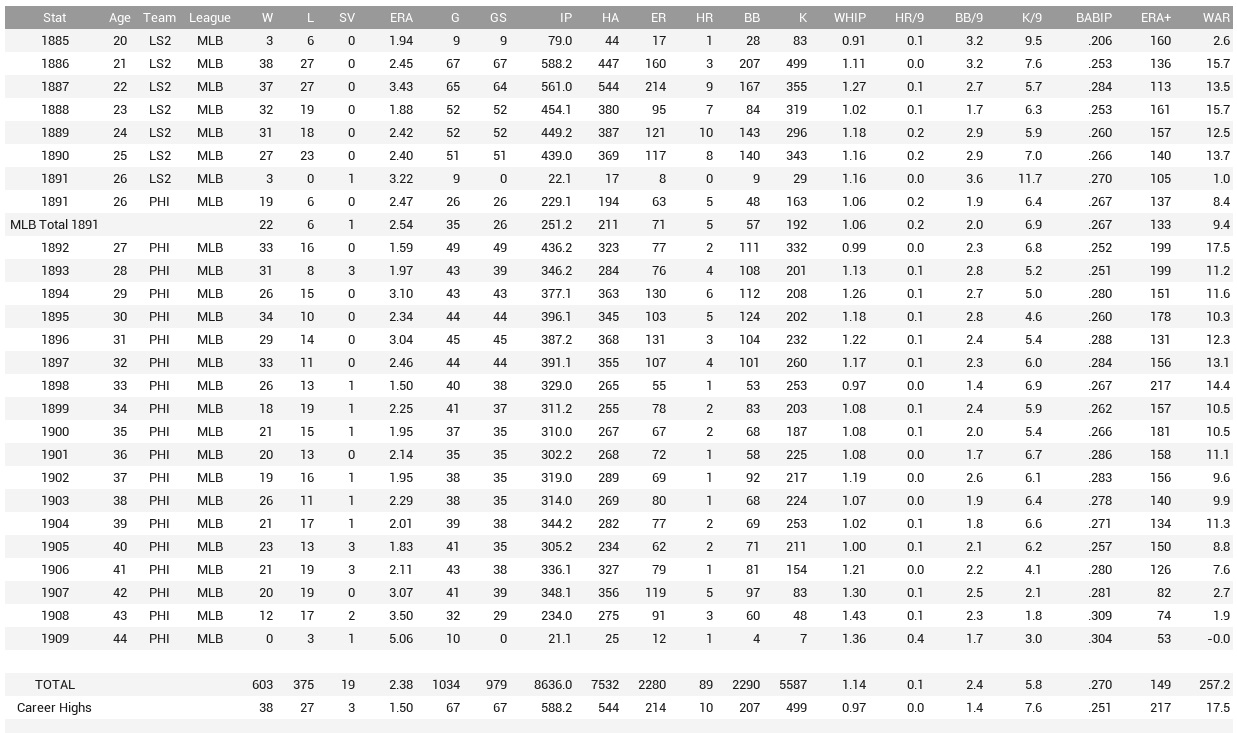Charlie Ferguson was a young promising pitcher for the Philadelphia Quakers in the 1880’s who more than held his own with the bat. SABR biographer Paul Hoffman claims that Charlie Ferguson was one of the “first tragic figures in major-league baseball” and could have “become one of the greatest players of all time”. Ferguson passed away at the age of 25 before the 1888 season from typhoid fever. His career stats were impressive.
On some days when he wasn’t pitching, he played in the field. In what would be his final season, he played 27 games at 2B, 5 at 3B, and 6 in the OF. In 300 plate appearances, he hit .337 with 85 RBIs, 13 SB, and an .886 OPS. He was well on his way to being an everyday player.
In his SABR bio, Hoffman notes that in 1925 – a whole 37 years after his death – a sports editor for the Philadelphia Evening Public Ledger called Ferguson “the greatest ballplayer who ever lived.” Hoffman concludes the bio by saying “One can only imagine how many games Ferguson might have won or what kind of everyday player he would have developed into had he lived to play an additional 12 to 15 years.”
 Charlie Ferguson (from Baseball-Reference.com)
Charlie Ferguson (from Baseball-Reference.com)
We decided to imagine by replaying history as if Charlie had never succumbed to typhoid fever.
We went back to 1888 using OOTP 2016 (and restructured the league to have accurate teams and rosters for that year). Charlie Ferguson then took his rightful place at the top of the rotation as well as their starting second baseman on days he did not pitch (all team settings were set to AI control except for the lineups and rotation for Philadelphia to accommodate for Ferguson playing every day. The game AI was in charge of everything else including all trades and signings).
The 1888 season for the Philadelphia Quakers as a whole did not start off too well. After a quick start they had fallen back to .500 by mid-May. Then the injury bug hit, and four regulars went down for the bulk of the rest of the year. While the Quakers rallied in the second half, they had dug themselves too deep a hole behind the Detroit Wolverines. Ferguson finished the season 30-23 with a 2.50 ERA and a 0.99 WHIP, leading the National League in WAR (10.1), innings pitched (479.2), most K/9 (4.50), and fewest BB/9 (1.05). He was tied for second in shutouts with 3. At the plate he hit a respectable .275 in 374 AB with 6 HR and 44 RBI, finishing with a 3.7 batting WAR, which was third on the Quakers.
His 1889 season ended early as he succumbed to injury on June 20th. While his pitching that year was not up to par (10-10, 3.61 ERA, 1.36 WHIP) his bat was more than making up for it. He had been leading the National League in OPS (.971) and was second in BA, OBP, and SLG when he went down.
In 1890, the now 27-year old was hitting his prime. The Quakers had now officially changed their name to the Phillies, and Ferguson continued to anchor their pitching staff. The Phillies were a game behind the Pittsburgh Alleghenys approaching the last series of the season. As luck would have it, they faced the Alleghenys in that series. Ferguson was given the ball for the first game of the three-game set. Unfortunately, Ferguson did not have his best stuff and he wasn’t helped by 5 Phillies errors. The Pirates won 7-2. They finished 91-63, one game behind Pittsburgh. That last start notwithstanding, Ferguson had bounced back from his injury to further his reputation, going 27-19 and leading the league in ERA (2.28) and WHIP (1.10). He finished 3rd in WAR (9.9). Playing right field when he wasn’t pitching, he again finished third on the team in batting WAR (3.9), hitting .283 with 73 RBI. If baseball back then had a most valuable player award and an award to honor the best pitcher, Ferguson would have won both of them.
1891 once again started slowly for both the Phillies, who quickly sank to 7th place and stayed there for most of the year. Management wouldn’t have it, and made the deal that would be celebrated for a generation. The Phillies traded four players: Billy Clingman, Fred Siefke, Bill Merritt, and Floyd Ritter to the Louisville Colonels for Toad Ramsey.
Toad, apart from having a memorable first name, is widely credited with inventing the knuckleball thanks to a tendon injury he had suffered in his index finger. In 1886 and 1887 he had two dominant seasons including one where he struck out 499 batters. In real life his career took a very quick downturn and he was out of the league after the 1890 season. However, in this world he was still the single most dominant pitcher in the American Association, winning 165 games over five years.
 Toad Ramsey (from Baseball-Reference.com)
Toad Ramsey (from Baseball-Reference.com)
The deal struck new life into the Phillies who went on a second half tear. In September they brought it to a new level, winning an incredible 16 straight games to end the season, with Ferguson winning his last 7 starts. But it was too little too late as they finished 2 games behind the Chicago Colts. But with two superstars leading the team, the time was ripe for the Phillies to finally make a push for a championship.
1892 turned out to be Ferguson’s best year yet. He tossed his first no-hitter on August 19th against the Pittsburgh Pirates, giving up only 1 walk. Ferguson and Toad Ramsey provided a dominant one-two punch that propelled the Phillies to their first ever National League pennant.* While Ferguson certainly shined, going 28-20 with a 2.24 ERA, 1.05 WHIP and 11.7 WAR, he was outdone by Toad who won the pitching triple crown, going 33-16 with a 1.59 ERA and 332 Ks.
With Toad and Ferguson, the Phillies cruised to the NL pennant again in 1893, finishing 13 games ahead of the Pirates. Ramsey won the pitching triple crown for the second straight year going an amazing 31-8 with a 1.97 ERA and 201 Ks. Ferguson again played second fiddle going 25-10 with a 3.25 ERA.
Toad would continue his amazing run, winning the pitching triple crown for an incredible third straight year in 1894, and fourth in 1895. But not all was stellar with Ferguson. In 1893 he had his worst season on the mound since his injury-shortened 1889 campaign, with the fewest wins, innings pitched, Ks, and WAR since that season. As their center fielder on days when he wasn’t pitching, Ferguson also had his worst year at the plate since his rookie campaign of 1884, hitting only .248 with 47 RBI and a 1.4 WAR in 508 plate appearances. Was the grind of playing every day getting to him?
Prior to the 1895 season in which Ferguson’s pitching stats declined farther, the decision was made to remove him from playing the field on his non-pitching days. Instead, Kid Gleason – who would often have the back end spot in the Phillies rotation – became a full time 3B, allowing Ferguson to focus solely on pitching. That move paid off as Ferguson had a bounce-back year at the age of 32, going 28-11 with a 2.75 ERA and a 9.2 WAR. The added rest also helped his hitting, as he topped .300 for the first time since 1889. More importantly Ferguson and Ramsey once again led the Phillies to a runaway NL pennant, as they won the league by 21 games over Cincinnati.
On May 9, 1896 Charlie Ferguson and the Phillies beat the Pittsburgh Pirates 17-1 for Ferguson’s 300th win, going the distance and giving up only 5 hits and no walks. Although the Phillies fell short of the pennant that season, Ferguson and Ramsey would win it again in 1897 for the Phillies’ fourth title.
Things went downhill for the Phillies as the century came to a close. They were leading the National League in late June of 1898 but then went on a 7-30 run to drop to last place despite excellent pitching from Ferguson and Ramsey. Ramsey would once again win the pitching triple crown (for an incredible 5th time in his career) and also notched his 400th win during that campaign.
Ferguson would get his 400th win in July of 1900 in a 3-2 win over the Chicago Orphans. The Phillies were back on top as they had signed Deacon Phillippe who now gave the Phillies three formidable starters. They won the National League pennant by 11 games over the Brooklyn Superbas.
That would be Ferguson’s and Ramsey’s last pennant. Toad would go on to win his 450th game in June of 1901, and Ferguson his in July of 1903 at the age of 40. On August 15th 1903, 39-year old Toad Ramsey beat the Chicago Cubs 9-4 for his 500th career win, but those two milestones weren’t enough as the Phillies finished third in the NL. In 1904 Ferguson would be removed from the rotation and relegated to mop up duties while Ramsey remained strong, winning his unprecedented 550th game September 27, 1905. and his 600th on July 31, 1908.
Ferguson would retire at the end of the 1905 season with a career record of 456-312, a 2.85 ERA and a 146.2 career WAR. His 456 wins would have put him second behind Cy Young, and his 146.2 career WAR would have been third behind Cy Young and Walter Johnson.
Toad would stick around for four more seasons, and would win his 600th game on July 31, 1908. He retired at the end of the 1909 season with a mind-boggling 603 wins, 5587 strikeouts, and a career 257.2 WAR. His wins and career WAR would top today’s all-time leaderboard, as would his 8636 career innings pitched. He would have been second all-time in strikeouts behind Nolan Ryan.
Meanwhile, without Charlie Ferguson and Toad Ramsey the real life Phillies would have to wait until 1915 for their first pennant and 1980 for their first World Series win.
* The World Series in its present form did not start until 1903. There was a championship series between the American Association and the National League up until the American Association folded after the 1891 season. While in some years there was either a split season championship series or a 1st vs 2nd place series at the end of the year, those permutations were not included in this sim, so there was no championship series from 1892 until 1903.
Follow us on Twitter @BullpenByComm



This is utterly amazing ! Thank you for the education in the brief career of Charlie Ferguson !
I am guessing you had recalculation turned off and the players developed off from their 1888 stats. Is that right?
Hi Lyle. Thanks for checking us out. Player ratings were recalculated each year based on real stats with the base being 3 years. Players (obviously) were not retired based on their actual retirement year. So for Charlie and Toad their ratings were based on the last three years of their career and then left up to the whims of the OOTP development algorithms.
Ah. So recalculation was turned on, but they weren’t checked to retire when they died or retired. Cool stuff. Thanks for the response.
Thanks Travis! Appreciate the feedback.